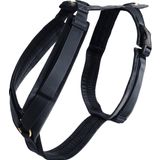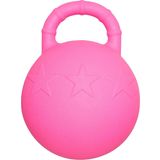Dog and Horse: What Should be Considered?
Most of the people who ride and own horses are also passionate about dogs. If you are one of these people then you may be considering taking your dog into the stable while you look after your horse. However, since a horse is a prey animal and a dog is a predator, an important question arises: Is it possible for these two species, which have such different instincts, to get along?
Much depends on your dog's behaviour and whether or not your horse has had positive experiences with dogs. In order for these two animals to get along, there are a few key steps you must first follow to ensure the safety of everyone involved. If you are a customer at a riding school, you should of course first ask the owner for permission to let your dog on the premises, as the presence of dogs around horses can be extremely dangerous.
Let's take a look at how to safely introduce your dog to horses and what else you need to know when your dog is in the stable.
Introducing your dog to horses
It tends to be the case that dogs approach horses faster than the other way round, because the latter are flight animals and are therefore naturally more cautious. If a dog approaches a horse too quickly, the horse can become frightened, which stimulates the dog's hunting instinct. So you have to make sure that you get to know each other for the first time.
But first, you need to consider your dog's breed and temperament. Hunting dog breeds such as Beagles are bred to hunt animals and birds, while a herding dog, such as the border collie, wants to control and tend the cattle. An excitable dog can startle a horse, and a frightened dog can even try to bite it. As a result, your horse may panic as its flight instinct kicks in and injure itself or others while it tries to escape from the "predator". Alternatively, if your horse defends itself, your dog could get under the hoofs quickly.
So it is important that you train your dog to behave and obey calmly and respectfully around horses. Most importantly, take it very slowly. As soon as you see the slightest sign of restlessness or fear in any of the animals, stop and try again in a few days. If the dog reacts negatively, it is important not to punish him. Screaming and punishment can be confusing to a dog and he will only associate this with the entire experience. Instead, find ways to use positive reinforcement and try to pay close attention to your dog's behaviour so you can stop a negative reaction before it sets in.
Ideally, a dog should be used to horses as a puppy. That would be the optimal case, but it does not always correspond to reality. If you have a dog that you only got when it was older, that is of course no longer possible. So let's take a closer look at both scenarios.
Puppy
If you already have a dog as a puppy, you can start slowly and step by step to get him used to horses. First let the dog observe horses from a distance, then after a while lead him past horses on the leash and reward him with treats for good behaviour.
Once he has no more problems with that, you can, by carrying him in your arms, lead him to a horse you know is friendly and let the animals sniff each other. If your pup has had a good experience with horses, he will likely be respectful of them and less inclined to chase a horse when he is older.
Older dogs
Your dog should be obedient to simple commands, both on and off the lead, and be reliable. As with a puppy, start gradually by leading your dog on a leash to horses that are quite far away. If you keep calm, you can step closer and ask your dog to sit down until you say otherwise. Your dog should also be familiar with the “stay” command and walk on a leash without pulling.
As your dog becomes more confident, approach the horse from the side where he can see you. Praise good behaviour by giving the dog small treats and turn away or move away from the horse if your dog becomes nervous or restless. By taking small steps and keeping the habituation periods short, your dog will learn to behave calmly and well around horses, so that you can ultimately spend quality time with your two favourite furry friends!
What to do if a horse has a problem with dogs
Sometimes it is not the dog that has to be slowly introduced to the horse, but the other way around. If a bad canine experience has settled in a horse's brain, it must be re-introduced to dogs with care.
The process is similar to the dog's first encounter with a horse. You want to be sure that the dog you choose is not responding to the horse's nervousness.
Start again with the dog on a leash some distance from the horse. Have someone else work the horse by feeding them treats, grooming them, or doing something else the horse enjoys. It is important that after the first 15-20 minutes of training you can no longer only use food as a reward, because horses then simply become intrusive.
The dog should only approach if the horse remains relaxed. When they are face to face, it is just as important that the horse sniff the dog and vice versa. Keep the dog away from the horse's hind legs and observe the body language of both animals to assess whether the situation is likely to become uncomfortable.
Possible dangers for dogs in the riding stables
Once your puppy or adult dog is calm around horses, you may want them to accompany you to the stables on a regular basis. However, there are some dangers to dogs that owners should be aware of.
De-wormer for horses
Deworming agents for horses are much more concentrated than those for dogs and also contain substances that are extremely toxic to dogs, with some dog breeds being particularly sensitive. So you always need to watch out for wormers that are lying around and could be chewed by dogs, as well as paste that falls on the floor that your dog can easily ingest by licking.
Often dogs also eat horse droppings. While this is just plain gross to many people, it is usually not harmful to dogs! After horses have been dewormed, however, they contain a large amount of substances that are problematic for dogs, even for several weeks. Therefore you have to be particularly vigilant during this time and not let your dogs run around freely in the stable and yard.
A suspected poisoned dog shows symptoms such as vomiting, fatigue, or seizures within a few hours that require immediate veterinary attention.
Shoeing
Dogs love hoof waste as a delicacy and are always happy when the farrier is there to shod the horses! As a rule, it is completely safe for most dogs to chew or eat fresh hoof shavings, as they contain calcium, protein and biotin.
However, problems can arise with horses being treated for foot conditions such as thrush or when hoof oil is applied, as the chemicals used in these treatments are toxic to dogs. Large or sharp fragments that are swallowed by a dog could also irritate or even perforate the stomach, intestines, or oesophagus. In addition, old and dry clippings are likely to be contaminated with mould or bacteria and may contain mycotoxins, which of course is problematic if eaten by dogs.
It is therefore best to always sweep up hoof waste and dispose of it when your farrier has finished shoeing horses on the farm.
Horse feed
It is not uncommon for dogs to eat horse feed and if only a small amount is eaten it shouldn't be a problem. However, if your dog eats a large amount it can get sick, which again requires immediate veterinary attention.
Another danger if your dog eats horse feed is that it may have added medication that can be fatal to dogs. Again, a visit to a veterinarian is necessary if your dog eats horse feed and then shows symptoms such as vomiting, diarrhoea, tremors, seizures or the like.
Conclusion
Spending time with your horse and dog is a wonderful experience. However, you should always make sure that your dog feels safe and calm around horses. In addition, he shouldn't annoy other customers at the yard. Just because your horse has no problem with dogs does not apply to other horses. You must therefore always be careful and have your dog under control. Otherwise, it can quickly become very dangerous for those involved as well as for bystanders.
Also, always throw away all hoof waste quickly, make sure your dog does not have access to horse worming agents or horse feed, and prevent him from eating manure.
If you follow these guidelines and give your dog enough time to get used to horses, they will be safe and happy even in the presence of horses.
Related products
-
 4.9 (18)
4.9 (18)CharLine Charcoal Feed Powder for Dogs, 450 g
- Eliminates harmful substances
- Supports the gastrointestinal tract
- Odourless & tasteless
€ 46,99 (€ 104,42 / kg)Delivery by January 21
-
 5.0 (2)
5.0 (2)Kentucky Dogwear Velvet Dog Harness, Black, L (38-58)cm
-40%- For long periods of wear
- Easy to put on
- Adjustable in three places
€ 29,99 € 49,99Delivery by January 21
-

Dog's Love Organic Turkey Dog Treats, 150 g
- Air-dried & grain-free
- Manufactured with care
- 97% organic meat
€ 9,99 (€ 66,60 / kg)Delivery by January 21
-
 4.3 (3)
4.3 (3)Imperial Riding Ball for Horses & Dogs, Hot Pink
- Hot Pink
- Royal Blue
- Diameter: 25 cm
- For the paddock or stable
- Made of soft plastic
€ 39,99Delivery by January 21
